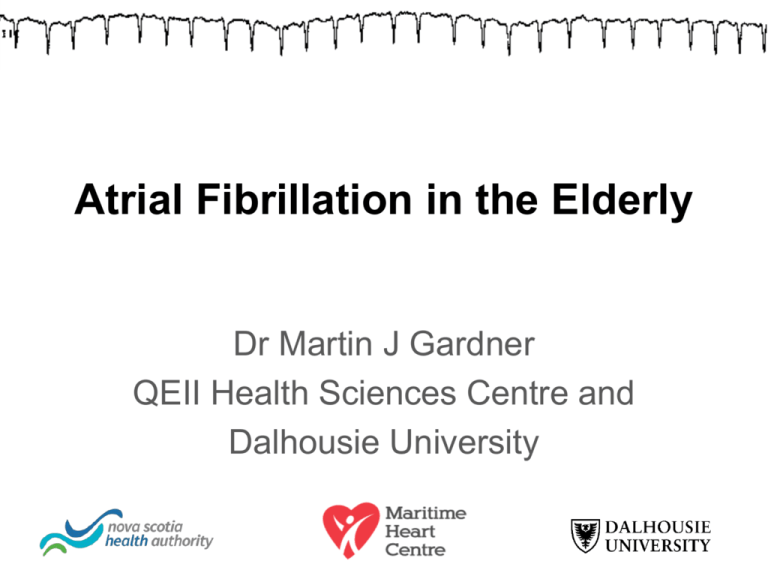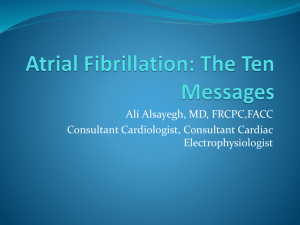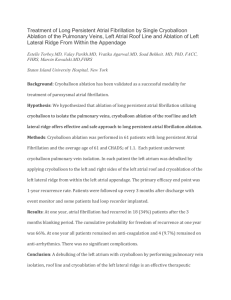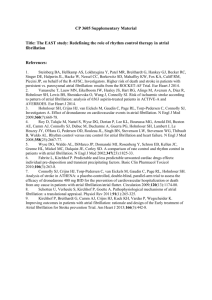Atrial Fibrillation in the Elderly
advertisement

Atrial Fibrillation in the Elderly Dr Martin J Gardner QEII Health Sciences Centre and Dalhousie University Disclosure • Speakers fees/ grants: – Medtronic of Canada – St Jude Canada Atrial Fibrillation Management • Review recommendations for: – Prevention – Investigation – Stroke prevention – Rhythm management • Drugs • Catheter ablation • Indicate what I do Atrial Fibrillation Guidelines Canadian Cardiovascular Society 2011/2012 http://www.ccsguidelineprograms.ca/atrial-fibrillation-guidelines-program/ European Society of Cardiology/ European Heart Rhythm Association 2010 http://eurheartj.oxfordjournals.org/content/ehj/31/19/2369.full.pdf 2011 ACCF/AHA/HRS Focused Update on the Management of Patients with AF http://circ.ahajournals.org/content/123/1/104.extract Case Study • • • • • • • • • • 75 year old man History of hypertension and diabetes No cardiac history Regular visit with you for BP check and complains of mild fatigue Medications: losartan/HCTZ, metformin, ASA Otherwise well Height: 1.75 m Weight: 98 kg BP: 166/92 Pulse: irregular Atrial Fibrillation • • • • • • Does he have symptoms? What symptoms are caused by atrial fibrillation? How do you control the symptoms? Is there a risk of stroke? How do you reduce the risk of stroke? Can atrial fibrillation be prevented? Cumulative Risk for AF Figure 1 Lloyd-Jones DM, Wang TJ, Leip EP, Larson MG, Levy D, Vasan RS, et al. Lifetime risk for development of atrial fibrillation: the Framingham Heart Study. Circulation. 2004 Aug 31;110(9): 1042-1046. Prevalence of Atrial Fibrillation Figure 2 Go AS, Hylek EM, Phillips KA, Chang Y, Henault LE, Selby JV, et al. Prevalence of diagnosed atrial fibrillation in adults: national implications for rhythm management and stroke prevention: the AnTicoagulation and Risk Factors in Atrial Fibrillation (ATRIA) Study. JAMA. 2001 May 9; 285(18): 2370-2375. Assessment and Prevention “Upstream” Therapy Primary Prevention Agents Considered: ACE inhibitors, Angiotensin receptor blockers, Aldosterone antagonists Statins, PUFAs European Heart Rhythm Association, European Association for CardioThoracic Surgery, Camm AJ, Kirchhof P, Lip GY, Schotten U, et al. Guidelines for the management of atrial fibrillation: the Task Force for the Management of Atrial Fibrillation of the European Society of Cardiology (ESC). Eur Heart J. 2010 Oct 31; 31(19): 2369-2429. Etiology and Investigations All patients with atrial fibrillation should have a complete history and physical examination, electrocardiogram, echocardiogram, basic laboratory investigations. Strong Recommendation Low Quality Evidence History Establish Severity (including impact on QoL) Identify Etiology Identify reversible causes (hyperthyroidism, ventricular pacing, SVT, exercise) Identify factors whose treatment could reduce recurrent AF or improve overall prognosis (i.e. hypertension, sleep apnea, left ventricular dysfunction) Identify potential triggers (i.e. alcohol, intensive aerobic training) Identify potentially heritable causes of AF (particularly in lone AF) Determine thrombo-embolic risk (e.g. CHADS2 Score) Determine bleeding risk to guide appropriate anti-thrombotic therapy Review prior pharmacologic therapy for AF, for efficacy and adverse effects What I do for Elderly AF Patients • • • • • Complete history, physical, ECG, ± Echocardiogram Evaluate stroke risk Document that symptoms are really from atrial fibrillation Establish severity of AF for each patient Look for all precipitating/ aggravating factors and treat aggressively • Treat hypertension with a view to rate controlling medications and ACE I/ ARBs • Don’t forget heart failure; sleep apnea What I Do • Recognize that every patient with A Fib is different • There is no one way to treat A Fib • Important to determine the impact of A Fib on the persons well being (QoL) Establish AF Severity Use to Guide Therapeutic Approach CCS SAF Score Impact on QOL 0 Asymptomatic 1 Minimal effect on QOL Single episode of AF without heart failure 2 Minor effect of QOL Mild awareness in persistent AF, or rare episodes (less than a few per year) in paroxysmal Moderate effect on QOL Moderate awareness of symptoms on most days in persistent AF, or more common episodes (more than every few months) or more severe symptoms or both in paroxysmal AF Severe effect on QOL Very unpleasant symptoms in persistent AF; frequent and highly symptomatic paroxysmal AF; syncope due to AF, CHF secondary to AF 3 4 Example Dorian P, Cvitkovic SS, Kerr CR, Crystal E, Gillis AM, Guerra PG, et al. A novel, simple scale for assessing the symptom severity of atrial fibrillation at the bedside: the CCS-SAF scale. Can J Cardiol 2006 Apr; 22(5): 383-386. Management Overview of AF Management AF Detected Detection and Treatment of Precipitating Causes Overview of AF Management AF Detected Assessment of Thromboembolic Risk (CHADS2) ASA OAC Stroke Risk - CHADS2 • • • • • Congestive heart failure Hypertension Age (>75) Diabetes Stroke/ TIA Risk of Stroke • With no risk factors • With one risk factor • With > one risk factor 1 %/yr 4-6%/yr 6-10%/yr Risk of Bleeding • HAS-BLED Score – one point each: – – – – – – – Uncontrolled hypertension Renal dysfunction (CC <30) Liver disease (bilirubin >2x; ALT/AST >3x) Prior major bleeding Age > 65 Medication (ASA) Alcohol (>8 drinks/wk) Risk of Bleeding HAS-BLED Score • 0 • 1-2 • 3 or more 0.9%/yr 3-4%/yr >5%/yr Annualized Rates of Warfarin-Associated Extracranial and Intracranial Hemorrhage by age (unadjusted) Figure 2 Fang MC, Go AS, Hylek EM, Chang Y, Henault LE, Jensvold NG, et al. Age and risk factor of warfarin-associated hemorrhage: the Anticoagulation and Risk Factors in Atrial Fibrillation Study. J Am Geriatr Soc. 2006 Aug; 54(8): 1231 – 1236. Figure 1 Macle L, Cairns JA, Andrade JG, Mitchell LB, Nattell S, Verma A, et al. The 2014 atrial fibrillation guidelines companion: a practical approach to the use of the Canadian Cardiovascular Society guidelines. Can J Cardiol. 2015 Oct; 31(10): 1207-1218. Figure 1 Macle L, Cairns JA, Andrade JG, Mitchell LB, Nattell S, Verma A, et al. The 2014 atrial fibrillation guidelines companion: a practical approach to the use of the Canadian Cardiovascular Society guidelines. Can J Cardiol. 2015 Oct; 31(10): 12071218. Figure 2 Skanes AC, Healey JS, Cairns JA, Dorian P, Gillis AM, McMurtry MS, et al. Focused 2012 update of the Canadian Cardiovascular Society atrial fibrillation guidelines: recommendations for stroke prevention and rate/rhythym control. Can J Cardiol. 2012 Mar - Apr; 28(2): 125 – 136. Figure 2 Skanes AC, Healey JS, Cairns JA, Dorian P, Gillis AM, McMurtry MS, et al. Focused 2012 update of the Canadian Cardiovascular Society atrial fibrillation guidelines: recommendations for stroke prevention and rate/rhythym control. Can J Cardiol. 2012 Mar - Apr; 28(2): 125 – 136. Figure 2 Skanes AC, Healey JS, Cairns JA, Dorian P, Gillis AM, McMurtry MS, et al. Focused 2012 update of the Canadian Cardiovascular Society atrial fibrillation guidelines: recommendations for stroke prevention and rate/rhythym control. Can J Cardiol. 2012 Mar - Apr; 28(2): 125 – 136. Figure 2 Skanes AC, Healey JS, Cairns JA, Dorian P, Gillis AM, McMurtry MS, et al. Focused 2012 update of the Canadian Cardiovascular Society atrial fibrillation guidelines: recommendations for stroke prevention and rate/rhythym control. Can J Cardiol. 2012 Mar - Apr; 28(2): 125 – 136. Which Anticoagulant Drug? • • • • • Warfarin Dabigatran Rivaroxaban Apixaban Edoxaban NOACs DOACs Which Anticoagulant Drug? • Warfarin – Inexpensive – Requires INR measurements – May be more difficult to maintain therapeutic INR – Anticoagulation can be reversed Which Anticoagulant Drug? • DOACs – Expensive and not always covered – Does not require INR measurements – May cause excess bleeding with renal impairment and low body weight (need to calculate creatinine clearance) – Creatinine needs to be monitored – Non-reversal/ Short half life Renal Impairment 1. Hart RG, Eikelboom JW, Brimble KS, McMurtry MS, Ingram AJ. Stroke prevention in atrial fibrillation patients with chronic kidney disease. Can J Cardiol. 2013 Jul; 29(7): S71 – 78. 2. Olesen JB, Lip GY, Kamper AL, Hommel K. Kober L, Lane DA, et al. Stroke and bleeding in atrial fibrillation with chronic kidney disease. N Engl J Med. 2012 Aug 16; 367(7): 625 – 35. 3. Capodanno D, Angiolillo DJ. Antithrombotic therapy in patients with chronic kidney disease. Circulation. 2012 May 29; 125(21): 2649 – 2661. ROCKET AF: Rivaroxaban in Patients With AF and Moderate Renal Impairment Patients with AF and reduced renal function have increased risk of stroke and bleeding 2,950 patients (20.7%) had moderate renal impairment (CrCl 30–49 mL/min) Results Efficacy and safety results with reduced-dose rivaroxaban (15 mg OD for patients with CrCl 30–49 mL/min) versus dose-adjusted warfarin were consistent with the overall trial results Conclusion Results support use of rivaroxaban as an effective alternative to warfarin for stroke prevention in patients with moderate renal impairment Primary endpoint: stroke/SE Cumulative event rate (%) Background/rationale 6 2.8%/yr Warf. CrCl 30–49 mL/min Riva. CrCl 30–49 mL/min Warf. overall Riva. overall 5 4 2.3%/yr 2.2%/yr 1.7%/yr 3 2 HR (95% CI) riva. vs. warf.: CrCl 30–49 mL/min: 0.84 (0.57–1.23) CrCl overall: 0.79 (0.66–0.96) 1 0 0 120 Major bleeding Critical ICH Fatal 240 360 480 600 720 Days from randomization CrCl 30–49 mL/min (%/year) Riva. Warf. 4.49 4.70 0.76 1.39 0.71 0.88 0.28 0.74 840 CrCl ≥50 mL/min (%/year) Riva. Warf. 3.39 3.17 0.83 1.13 0.44 0.71 0.23 0.43 Fox KAA, Piccini JP, Wojdyla D, Becker RC, Halperin JL, Nessel CC, et al. Prevention of stroke and systemic embolism with rivaroxaban compared with warfarin in patients with non-valvular atrial fibrillation and moderate renal impairment. Eur Heart J. 2011 Oct; 32(19):2387–2394; Patel MR, Mahaffey KW, Garg J, Pan G, Singer DE, Hacke W, et al. Rivaroxaban versus warfarin in nonvalvular atrial fibrillation. N Engl J Med. 2011 Sept 8; 365(10):883–891. pvalue (int.) 0.48 0.39 0.51 0.53 Macle L, Cairns JA, Andrade JG, Mitchell LB, Nattell S, Verma A, et al. The 2014 atrial fibrillation guidelines companion: a practical approach to the use of the Canadian Cardiovascular Society guidelines. Can J Cardiol. 2015 Oct; 31(10): 12071218. Which Anticoagulant Drug? • • • • • Warfarin Dabigatran Rivaroxaban Apixaban Edoxaban NOACs DOACs Overview of AF Management AF Detected Management of Arrhythmia Rate Control Rhythm Control Goals of AF Arrhythmia Management • Identify and treat underlying structural heart disease and other predisposing conditions • Relieve symptoms • Improve functional capacity/quality of life • Reduce morbidity/mortality associated with AF/AFL – Reduce/prevent emergency room visits or hospitalizations secondary to AF/AFL – Prevent stroke or systemic thromboembolism Rate or Rhythm Control? • How do you decide if you are going to pursue rate or rhythm control for a patient with AF? • No right or wrong answer • Often, the two are simultaneous: – Rhythm control requires good rate control when patient goes back into AF • Need to continuously re-evaluate the strategy as the AF progresses – What may have been a good initial strategy may no longer be warranted What I Do • Let symptoms be your guide • Most elderly patients will benefit from rate control • Use rhythm control only when there are more symptoms due to AF and less underlying heart disease • Be aggressive with rate control Rate Control Drug Choices No Heart Disease Hypertension CAD β-blocker Diltiazem Verapamil Combination Rx Digitalis† β-blocker* Diltiazem Verapamil Heart Failure β-blocker ± digitalis *β-blockers preferred in CAD †Digitalis may be considered as monotherapy in sedentary individuals What is Optimal Target Heart Rate? • RACE II suggested that strict rate control (< 80 bpm at rest, < 110 bpm with activity) was no different compared to lenient strategy (< 110 bpm at rest) • However, actual HR in both groups were 75 and 86 bpm respectively • Thus, the trial was not that lenient • Few patients had HR > 100 bpm Van Gelder IC, Groenveld HF, Crijns HJ, Tuininga YS, Tijssen JG, Alings AM, et al. Lenient versus strict rate control in patients with atrial fibrillation. N Engl J Med. 2010 Apr 15; 362(15): 1363-73. What is Optimal Target Heart Rate? Figure 2 Van Gelder IC, Groenveld HF, Crijns HJ, Tuininga YS, Tijssen JG, Alings AM, et al. Lenient versus strict rate control in patients with atrial fibrillation. N Engl J Med. 2010 Apr 15; 362(15): 1363-73. What I Do – Rate Control • Measure rate at rest and with exercise • Accept a resting HR below 100/min • Be aware that persistent high heart rates can result in a tachycardia induced cardiomyopathy • Use combination therapy if needed Principles of Antiarrhythmic Drug Therapy to Maintain Sinus Rhythm 1. 2. 3. 4. 5. 6. Treatment is motivated by attempts to reduce symptoms Efficacy of antiarrhythmic drugs is modest Clinically successful antiarrhythmic drug therapy may reduce rather than eliminate recurrence of AF If one antiarrhythmic drug ‘fails’ a clinically acceptable response may be achieved with another agent Drug-induced proarrhythmia or side-effects are frequent Safety rather than efficacy considerations should primarily guide the choice of antiarrhythmic agent Antiarrhythmic Drug Choices Normal Ventricular Function Dronedarone Flecainide* Propafenone* Sotalol Catheter Ablation Amiodarone * Class I agents should be AVOIDED in CAD They should be combined with AV-nodal blocking agents Sotalol contraindicated in women >65 yrs taking diuretics Antiarrhythmic Drug Choices In The Elderly Dronedarone Flecainide* Propafenone* Sotalol Catheter Ablation Amiodarone What I Do • Use anti-arrhythmic medications for elderly patients with persistent and bothersome symptoms due to A Fib • Normal heart – Sotalol/ Amiodarone • Abnormal heart – Amiodarone • Goal is to REDUCE episodes (not eliminate) Rhythm Control Does Not Replace Anticoagulation • No evidence that AF reduction via antiarrhythmic therapy reduces the risk of stroke/thromboembolism • Patients must continue on appropriate anticoagulation according to their individual embolic risk (CHADS2 score) Catheter Ablation Systematic Review of RCTs Ablation vs Drug Rx Ablation Control RR 95% CI Forleo 2009 13/16 6/13 1.76 0.94, 3.31 Jais 2008 23/53 13/59 1.97 1.11, 3.48 Krittyaphong 2003 9/11 4/10 2.05 0.91, 4.59 Wazni 2005 31/35 12/32 2.36 1.49, 3.75 Wilber 2010 56/106 10/61 3.22 1.78, 5.84 Combined 132/221 45/175 2.26 1.74, 2.94 Ablation Control RR 95% CI Forleo 2009 28/35 9/22 1.96 1.15, 3.32 Krittyaphong 2003 3/4 3/6 1.50 0.56, 4.00 Oral 2006 32/77 3/69 9.56 3.06, 29.8 Stabile 2006 16/26 2/19 5.85 1.52, 22.5 Combined 79/142 17/116 3.29 1.29, 8.41 • Favours AAD Favours RFA • Paroxysmal AF Persistent AF uniformly demonstrate large differences in recurrence of AF RR 2.26 and 3.29 in favour of ablation vs AAD after a single procedure Parkash R, Tang ASL, Sapp JL, Wells G. Approach to the catheter ablation technique of paroxysmal and persistent atrial fibrillation: a meta-analysis of the randomized controlled trials. J Cardiovasc Electrophysiol. 2011 Jul; 22(7): 729 – 738. We recommend catheter ablation of AF in patients who remain symptomatic following adequate trials of anti-arrhythmic drug therapy and in whom a rhythm control strategy remains desired. Strong Recommendation Moderate Quality Evidence We suggest catheter ablation to maintain sinus rhythm in select patients with symptomatic AF and mild-moderate structural heart disease who are refractory or intolerant to at least one antiarrhythmic medication. Conditional Recommendation Moderate Quality Evidence We suggest catheter ablation to maintain sinus rhythm as first-line therapy for relief of symptoms in highly selected patients with symptomatic, paroxysmal AF. Conditional Recommendation Low Quality Evidence Values and Preferences: These recommendations recognize that the balance of risk with ablation and benefit in symptom relief and improvement in quality of life must be individualized. They also recognize that patients may have relative or absolute cardiac or non-cardiac contra-indications to specific medications. Case Study • • • • • • • • • • 75 year old man History of hypertension and diabetes No cardiac history Regular visit with you for BP check and complains of mild fatigue Medications: losartan/HCTZ, metformin, ASA Otherwise well Height: 1.75 m Weight: 98 kg BP: 166/92 Pulse: irregular Management • • • • Manage stroke risk – anticoagulation Weight BP control Assess rate with exercise – Use rate controlling drugs if needed • Check electrolytes, renal function, thyroid function • May consider cardioversion • Consider sleep apnea Referral for Specialty Care Most elderly patients with AF/AFl Rate control/ stroke prevention Patients who are remain highly symptomatic despite rate or rhythm control therapy Referral to arrhythmia specialist







